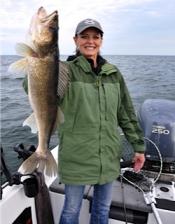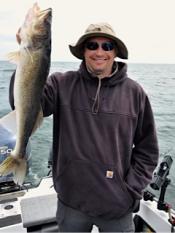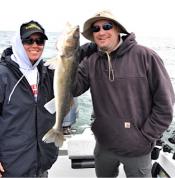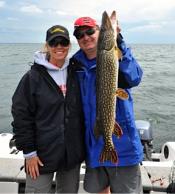 The explosion of zebra mussels and spiny water fleas in Mille Lacs Lake may change how anglers go about catching walleyes in the near future. Understanding how these invasive species affect a lake’s ecosystem and what a walleye angler can do to adapt to this change can help you put more walleyes in your boat. Open water trolling in deep water is one fishing technique that can help you combat these changing water conditions and as a result will become more popular.
The explosion of zebra mussels and spiny water fleas in Mille Lacs Lake may change how anglers go about catching walleyes in the near future. Understanding how these invasive species affect a lake’s ecosystem and what a walleye angler can do to adapt to this change can help you put more walleyes in your boat. Open water trolling in deep water is one fishing technique that can help you combat these changing water conditions and as a result will become more popular.
The number of zebra mussels in Lake Mille Lacs has increased 41 percent from 2011 to 2012. Areas tested in Mille Lacs now average over 1,300 zebra mussels per square foot. Zebra mussels are water-filtering machines and can filter up to a quart of water a day as they consume algae. At a density of 500 zebra mussels per square foot, the mussels can filter the entire water column above in a single day. The MN DNR now estimates that the water in Mille Lacs is being filtered at least once a day and possibly more. It’s easy to understand in this scenario why water clarity would improve. Today it’s becoming more evident. Many anglers are claiming that they have definitely seen clearer water conditions this spring and can now see structure below the surface like never before.
 Spiny Water Fleas is another invasive specie now present in Mille Lacs Lake. They feed on zooplankton (Daphnia) as they compete with smaller baitfish. In its native range it shows a preference for large, deep, clear lakes with relatively low summer bottom temperatures. They are thriving in Mille Lacs as well and it’s easy to see as they accumulate on your fishing line.
Spiny Water Fleas is another invasive specie now present in Mille Lacs Lake. They feed on zooplankton (Daphnia) as they compete with smaller baitfish. In its native range it shows a preference for large, deep, clear lakes with relatively low summer bottom temperatures. They are thriving in Mille Lacs as well and it’s easy to see as they accumulate on your fishing line.
Spiny water fleas could be controlled if fish could eat large quantities of them. However, their sharp spines can only be swallowed by larger fish and not by smaller fish. Because the fleas don’t have many predators, their populations grow rapidly. Since spiny water fleas eat zooplankton they can affect the water ecosystem as well. They compete directly with small fish that also need to eat zooplankton. Research shows that perch aren’t growing like they should and some young can’t survive because of the lack of food. A decrease in small baitfish could also take away a food source for walleyes in Mille Lacs.
The long-term negative effects of these two invasive species is yet to be determined. No two water ecosystems are alike so it’s difficult to predict and only time will tell on how Mille Lacs will fair. However one thing is certain, the Mille Lacs water ecosystem is changing and there’s not much we can do to stop it. However, we can adapt on how we go about fishing for walleyes!
 Location: Zebra mussels usually attach themselves to rocky areas and are mostly absent where the bottom is sand and mud. The southern half of Mille Lacs consists of gravel and rock areas, the NW quadrant of the lake consists of mud and the NE quadrant consists of sand. Clearer water has a tendency to warm up quicker due to light penetration. During the hot summer months, water temps may be warmer in the south areas of the lake. 1-2 degrees may make a big difference of where the tullibees will want to congregate especially when they are heat stressed. Walleyes typically like cooler and darker water as well where they can more easily ambush their prey. Areas that contain dirtier water may attract more tullibees and walleyes. Since the majority of the zebra mussels are located in the southern half of the lake, odds are it will be clearer water conditions with warmer water temperatures. Knowing this, suspended walleyes feeding on tullibees may congregate more in the mud and sand areas and it’s certainly something to consider when scouting for fish.
Location: Zebra mussels usually attach themselves to rocky areas and are mostly absent where the bottom is sand and mud. The southern half of Mille Lacs consists of gravel and rock areas, the NW quadrant of the lake consists of mud and the NE quadrant consists of sand. Clearer water has a tendency to warm up quicker due to light penetration. During the hot summer months, water temps may be warmer in the south areas of the lake. 1-2 degrees may make a big difference of where the tullibees will want to congregate especially when they are heat stressed. Walleyes typically like cooler and darker water as well where they can more easily ambush their prey. Areas that contain dirtier water may attract more tullibees and walleyes. Since the majority of the zebra mussels are located in the southern half of the lake, odds are it will be clearer water conditions with warmer water temperatures. Knowing this, suspended walleyes feeding on tullibees may congregate more in the mud and sand areas and it’s certainly something to consider when scouting for fish.
Depth: The walleyes and the baitfish they pursue may also prefer deeper, darker water as well. The deeper the water – odds are the cooler the water temperature. A gradual decrease in one foot of depth is a huge difference in a shallow lake like Mille Lacs. Pay extra attention to those contours on your sonar with your lake map chip and be sure to recognize those little changes. Open water trolling with lead core line allows you to place your crankbait deeper in the water column where these walleyes are swimming about.
Time of Day: With clearer water conditions, walleyes may seek more cover in weeds, move to deeper, darker water and may feed more after dark. Other lakes infested with zebra mussels such as Bay de Noc are now sometimes labeled as “night only fishing lakes”. Reason being is due to the clear water conditions, walleyes are extra spooky and can easily detect boat shadows above and they have a hard time catching baitfish themselves. The walleyes have learned to save their energy and feed mainly at night where they are not as easily detected by their prey.
 Fishing Pressure: I think it’s safe to assume as water clarity improves, walleyes will spook more. This has a compounding affect if you are fishing structure utilizing more traditional walleye catching techniques (rigging, jigging or corking) with other boats in the area. The walleyes will only tolerate so much pressure until they decide to relocate. Open water trolling allows you to get away from the crowds and you do not have to fish structure. I’m never closer than ½ mile to a flat. It allows you cover 2 miles of water in an hour and virtually troll areas where walleyes haven’t seen a boat all day long. Open water trolling also allows you to place your lure far away from the boat especially when you use planer boards. It’s not uncommon for me to have out over 200 feet of line on an outside planer board. The calmer the water surface, the farther away I will place those planer boards.
Fishing Pressure: I think it’s safe to assume as water clarity improves, walleyes will spook more. This has a compounding affect if you are fishing structure utilizing more traditional walleye catching techniques (rigging, jigging or corking) with other boats in the area. The walleyes will only tolerate so much pressure until they decide to relocate. Open water trolling allows you to get away from the crowds and you do not have to fish structure. I’m never closer than ½ mile to a flat. It allows you cover 2 miles of water in an hour and virtually troll areas where walleyes haven’t seen a boat all day long. Open water trolling also allows you to place your lure far away from the boat especially when you use planer boards. It’s not uncommon for me to have out over 200 feet of line on an outside planer board. The calmer the water surface, the farther away I will place those planer boards.
So Many In Numbers And The Law of Averages: As walleyes become more skittish in clearer water conditions, the more finicky they are about what they will eat. Trying to get a single spooky walleye to bite on a piece of structure may be an uphill battle. Open water trolling allows you to present your crankbait to a lot more walleyes and not to just a few. Most will not eat it but the more that come take a look, odds are, one will hit it. Open water trolling allows you to increase your chances for success especially during the months of July and August when walleyes are in their mid-summer patterns.
The popularity of open water trolling has increased over the years and will continue to rise as these invasive species continue to grow and change our lakes. When I started using the open water trolling method 13 years ago, I rarely saw anyone else doing it. Now, it’s not uncommon to see 10% of the boats doing it. If you would like to learn and perfect this system, I encourage you to check out my website below. Over the years, I’ve taken out numerous anglers and taught them this system during my Open Water / On The Water Trolling Clinics. I still have some openings in July and August and due to the late ice this spring – it should be really good. I’m also conducting one this coming Sat (June 22nd) and I have one open spot – so please let me know if you’re interested.
Good luck out there and until next time – keep trollin’!
Very interesting and informative read Brad.
I’m not challenging your findings so please don’t take this the wrong way.
Back when I chased brown trout on Green Bay every April, we always looked for the dirty water on wind blown shorelines. What we were really looking for was warmer water and we knew that when we found dirty water, it would be warmer than the surrounding clear water, which it always was. It’s also where we usually found most of our brown trout.
Now that was in April, not June, July & August. It was also on Green Bay, not Mill Lacs.
For me, a big part of fishing is the learning process which never stops if you intend to become a better fishermen every year.
When you have time, can you go into more detail concerning the clear water/dirty water and how/why clear water heats up faster than dirty water?
Thanks Joel for your kind words and you bring up a great question for discussion.
I agree with your statement above. Looking for warmer, dirtier water in April on one of the Great Lakes is a good strategy in finding fish and I’ve had similar success. That is where the baitfish love to congregate because at that time of the year, that’s where the forage base is located. I think the opposite in the heat of the summer and when water temps exceed 75 degrees.
It’s also difficult to compare that deep water ecosystem in April which has a thermocline versus a relatively shallow inland lake like Mille Lacs during the months of July and August. I’m no scientist and I don’t have a degree in biology, but the point I was trying to convey is if the zebra mussels are congregating in rocky/gravel areas in the southern half of Mille Lakes Lake, common sense tells me that part of the lake may be clearer due to all the filtration that is going on. Common sense again tells me that clearer water allows for more sunlight to penetrate and may result in warmer water temperatures. Warmer water has less oxygen than colder water. Tullibees do not do well in warmer water temperatures and must have cooler, oxygen rich water in order to survive otherwise they’ll become distressed. Last year was a prime example of that when you could see hundreds of them floating on the surface. So if I was going to go scout and look for tullibees and walleyes in the open water of Mille Lacs during the summer months of July and August, I would start by looking in areas that consisted of mud and sand.